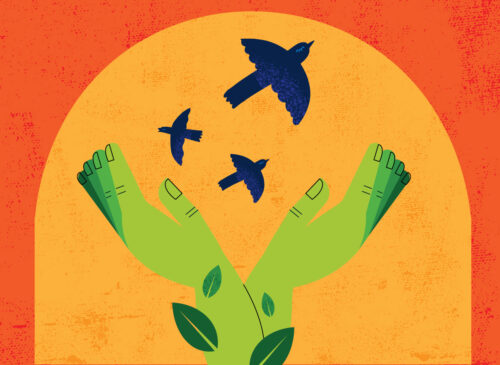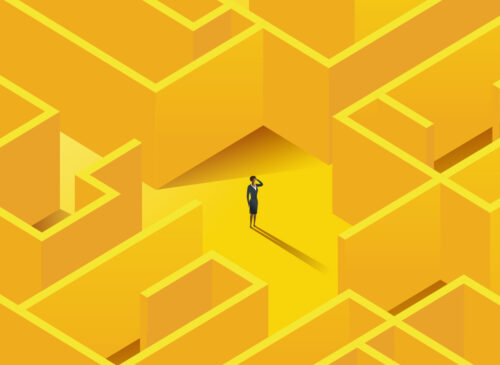To “take the long view” is to reflect, discuss, or dialogue on the effectiveness and/or power something will have in the future instead of the present. The 21st century is proceeding at a relentless pace of change. This has brought disruption to faculty across the Canadian landscape, including those who work in the Ontario university sector. Why is it important at this juncture to turn our collective intelligence and action to the future of Indigenous teacher education? What transformative ideas are unfurling in university teacher education programs by Indigenous faculty and their Indigenous students?
As an Indigenous professor, I carry two important perspectives that guide and shape my work. First, I identify with the Coastal Mountains of the Fraser Valley and the Big River in British Columbia known for thousands of years as the Stó:lō. The River and the People have the same name, Stó:lō. I am a river woman of the Stó:lō and learned at an early age that everything that fed our family came out of that river. Salmon, it is said by my elders, “is found in our bones. It is in our DNA.” Second, I have spent the better part of my adult life reclaiming my identity, renewing the foundational knowledge of culture and language, and walking the path as a peaceful warrior for social justice, equity, and women and children’s rights. I continue to work alongside Indigenous communities to bring a new era of Indigenous teacher education programs to the university and am deeply committed to mentoring the Indigenous scholars that are fulfilling their goals in higher education.
This is a point in time when a renewed commitment could be made by Faculties of Education to make bold curriculum and pedagogical change through acknowledgment that Indigenous epistemologies, cultural worldviews, and community partnerships have a place at the table of learning. Why does this matter more than ever in the halls and walls of the university? Relationship building does not happen because a document, a policy statement or a vision statement are signed and protocol is addressed. Let me explain.
Indigenous stories of the land, people, and culture are narratives that inform a way of respectful living. The stories are told time and again, sometimes seasonally, and often when protocol requires. This is how respectful relationships are formed and trust built over time. For example, in the spring season in my territory, there is the First Salmon Ceremony. The Elders share this story of the relationship that joins the People and the Salmon. It is an old story. The narrative is about sustainability and maintaining a relationship, so that the Salmon will always return to feed the People. It is more than preservation of an ecosystem, it is a deeper recognition that “respect, and setting things right,” are the ties, the roots, and the lineage narratives of language, culture, and history. The protocol, the ceremony, listening and sharing of the stories of salmon keep the community together through acknowledging the importance of harmony, and appreciating a shared value worth remembering and honouring. A renewed commitment from our universities to move Indigenous education goals and programs forward is necessary as we move into the next decade.
How confident are the voices of Aboriginal, Inuit, and Métis Faculty pioneering original educational research along with ground-breaking policy recommendations in our universities? Are they being awarded respect, tenure, and equity throughout the university system? What is to be made visible and to be acknowledged in an authentic manner by peers, deans, and presidents of our institutions? What are new Indigenous teacher-scholars bringing to the art of learning as they come through the doors to higher education? Respect. Continuity. Humour. Protocol. These words describe how to reach people, and how to change and open dialogue.
The timing of these questions has come as a six-year window opens towards the year 2020. This sense of urgency to change the “way things are done” throughout the university towards a more diverse, transparent, and equitable relationship has been made clear through strategic reports on Aboriginal education in the past four years. One, came from the Council of Ontario Universities, Unity Through Diversity. This is a summary report from 2012 containing an immediate call to “reframe” the need for Aboriginal education funding because of the simple fact that, “investing in the postsecondary education of Aboriginal youth makes great economic sense.” The other commendable document was designed by the Association of Canadian Deans of Education (2010), titled Accord on Indigenous Education. The Accord’s progressive goals give agency to the membership in the ACDE to foster respectful and welcoming learning environments; inclusive curricula; culturally responsive pedagogies; mechanisms for valuing and promoting indigeneity in education; culturally responsive assessment; affirming and revitalizing Indigenous languages; retention strategies for Indigenous education leadership; and to foster non-Indigenous learners and Indigeneity through reflection and dialogue. Will the academy falter and continue to be bystanders and detractors as a new wave of Indigenous learners enters the halls of higher learning while little change is made to the systemic refusal to understand the rich environmental narratives, stories of community, and the heartbreaking healing that is a constant throughout Indigenous urban and rural territories?
It is my hope that a deeper appreciation will take hold in all corners of the academy and that minds will be open when recommendations are brought forward by Indigenous educators. However, the perspective I offer is that for all the collective reports, policy documents, think-tanks and recommendation forums, there remains a “ceiling of power,” that refuses to examine their resistance to an Indigenous viewpoint. I offer a story. It is told by Richard West Jr., a citizen of the Cheyenne and Arapaho Tribes and a Peace Chief of the Southern Cheyenne. He is also a founding director of the Smithsonian Museum.
“The story begins by introducing a northern California Indian basket-maker, Mrs. Matt, who was hired to teach basket making at the local university. After three weeks, her students complained that all they had done was sing songs. When, they asked, were they going to learn to make baskets? Mrs. Matt, somewhat taken aback, replied that they were learning to make baskets. She explained that the process starts with songs that are sung so as not to insult the plants when the materials for the baskets are picked. So her students learned the songs and went to pick the grasses and plants to make their baskets. Upon their return to the classroom, however, the students again were dismayed when Mrs. Matt began to teach them yet more songs. This time she wanted them to learn the songs that must be sung as you soften the materials in your mouth before you start to weave. Exasperated, the students protested having to learn songs instead of learning to make baskets. Mrs. Matt, perhaps a bit exasperated herself at this point, thereupon patiently explained the obvious to them: “You’re missing the point,” she told them, “a basket is a song made visible.”
At the epicentre of Indigenous thought and philosophy is how to engage others in meaningful dialogue so as to make visible a worldview that is the foundation of all Aboriginal education. Indigenous student scholars are confronted with this negotiation for most of their undergraduate and graduate degree programs. Indigenous faculty, who themselves have had to swim through the treacherous waters of academic institutions to gain their degrees, continue to bring forward a deep appreciation for a way of learning and a philosophy of connectedness that anchors their original research and grant opportunities. Still, a glass ceiling of resistance is all too apparent when Indigenous faculty are challenged for suggesting innovative programs or pilot projects for reaching potential new students when funding is needed for travel to remote communities, or investment monies are needed to bring community partnerships into faculty programs. Funding agencies are reluctant to cover things like mobile computers or tablets when digital tools and software apps for Indigenous learning resources are necessary for a knowledgeable, mobile society.
An Indigenous ceremony involves a protocol that prepares the area for relationship building, a bringing together of everyone attending, acknowledging the territory, and setting a respectful intention for the work, the speaking, the listening, and the sharing that will commence. The four areas that may assist in resetting our Aboriginal education goals towards the year 2020 are: change, respect for Indigenous knowledge, opening doors for community partnership, and recognition of the new storytellers.
First, it is time to create talking circles that share the ways and the means of developing and maintaining positive, progressive relationships between Indigenous faculty and all levels of the university. There are many talented and creative individuals that have brought Indigenous stories of the land, people, language, and history through courses, research, film, literature, dance, art, and story. Each and every member of the university community needs to be part of the healing process that addresses the horrific residential school history. In order to accomplish this, knowledge, reflection, and dialogue will ultimately open hearts. We can support the commitment to Aboriginal education that plays a role in leading the way to restore a longed for salve of grace and humanity throughout the halls of learning. This is the change needed to move the long view of Aboriginal education into new waters by 2020.
Second, the research undertaken by Indigenous education scholars continues to crack open new possibilities for ways of learning, revising curriculum to teach literacy and to put into place project initiatives that reflect the priorities of Indigenous communities. It is time to create an innovative expression for the word “research.” The notable Maori Scholar, Dr. Linda Tuhiwai Smith, is well known for her use of the term “decolonizing methodologies” to herald a new era of conducting innovative approaches to pressing issues throughout Indigenous education. The context shift is towards valuing the role Indigenous knowledge, language and culture play in all aspects of the research process.
Third, it may be opportune to push forward interdisciplinary partnerships within the university that would benefit collaboration and exchange of ideas, course content, and epistemological approaches to learning. For example, consider the opportunity for the health sciences and education to bring about a greater exchange of knowledge when health professionals and Indigenous educators bring both nurses and teachers together to focus on improving the lives of Aboriginal children. The approach could bring about new collaborations that would resonate locally, provincially, and nationally. The same could be applied to environmental and resource management as well as the disciplines of science, engineering, and business. What is at stake is the future of our Aboriginal children. When we put our children’s success in the centre of all our discussions and decision-making, it becomes increasingly important to take on opportunities that foster innovation and encourage transparency. It takes leadership, partnerships and a will to envision a better world for our next generation of learners.
Finally, and perhaps the most exciting prospect found in Indigenous education today is the new teacher-scholars entering our universities. They are the new storytellers. I have met these extraordinary students in my classrooms, in online courses, in graduate seminars, and in community events and ceremonies. I have witnessed their honours projects in community forums, Aboriginal education media presentations and have been inspired by their ground-breaking thesis work. These new teacher-scholars are arriving with a sense of purpose to create learning environments that are relevant to Aboriginal children. They are asking the hard questions about racism, discrimination, and equity. There is a better way. They are part of this new revolution of change. After completing their education degree and gaining full teacher certification, these new teacher-scholars are now changing the landscape of their communities. They are influencing the next generation to succeed at school and are embracing education leadership roles. The new Aboriginal, Métis, and Inuit educators are forward thinking in creating partnerships that make sense economically, environmentally, and above all, are placing social justice at the front of all policy decision-making.
The long view towards Indigenous Education is that change takes time to gain momentum, to get the wheels in motion, and to keep going forward. This is not the moment in history to reduce funding for the aspects of Indigenous education that are necessary for growth and capacity building, such as community partnerships with northern communities, developing innovative course delivery, and retaining and hiring Indigenous faculty.
An Elder in Northern Ontario explains it this way: “as long as the grass grows and the wind blows, there is no mountain too high or valley too low, to keep the People from doing the work.” The long view must be kept in our sight for the children that are entering the classrooms of today and tomorrow. Somewhere by the Great Lakes is a native child preparing to lead the city of Toronto. Somewhere by the fast-moving river is a child preparing to take their place as the first Native Premier of the Province of Ontario. Somewhere walking the land is a native child destined to lead a nation as the first Indigenous Prime Minister of Canada. This is what it means to take the long view of Indigenous Education.
Chi Meegwetch. Thank you very much.










